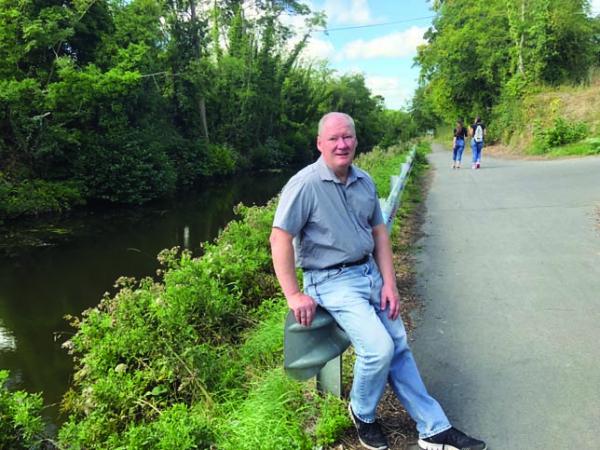February 27, 2019

Michael Shea sitting astride the Royal Canal.
Michael Shea, 55, at right, was raised in the small Western Massachusetts town of Blandford before graduating from Stonehill College in 1985. After obtaining a law degree, he practiced in Boston until moving to Ireland with his wife Margaret (a native of County Leitrim) in 1998. He has lived in Dublin since arriving in Ireland, and recently sat down to explain how he came to write a book about the Royal Canal, the stretch of water linking Dublin to the Shannon River and made famous in Brendan Behan’s song “The Auld Triangle.”
Q. How did you end up in Ireland?
A. With the Irish economy booming during the Celtic Tiger years we were able to move to Ireland in 1998 where I joined one of Ireland’s larger firms. Eventually that led to my becoming in-house counsel for some large US corporations that have also relocated to Ireland, so we’ve been in Dublin ever since.
Q. How did this book happen?
A. Well – a few years back a group at work decided to attempt the Ring of Kerry charity cycle. I thought it sounded like a good idea but then realized that I was committing to hopping on my bike and essentially cycling from Dublin to Galway.
Q. Wow – what’s a Massachusetts equivalent?
A. Pittsfield to Boston.
Q. Had you ever cycled before?
A. Sure, I had a bike until I was about 12 and I’d ride it about 200 yards to the store.
Q. So you were not an experienced cyclist.
A. That would be a “no.” I needed to train because I wasn’t 100 percent confident that I knew the finer points of cycling, like when to change gears - and I wasn’t sure that I would be able for it “fitness wise.”
Q. You mean the Ring of Kerry?
A. No – I mean the 200 yards to the store. I was 100 percent sure that I couldn’t do Kerry. At least not yet.
Q. So how does this lead to the Royal Canal?
A. Well, I got a bike and started looking for places to train. If you know the roads around Dublin, they aren’t bike friendly. Certainly not for a novice trying to safely re-learn cycling. So I went to the Royal Canal to train – it’s close to my house, has no traffic, forces you to work hard but isn’t too hilly. It was ideal.
Q. Why write about it?
A. Because beyond being a great place to train I kept running into things that made me ask questions. On one bridge there was a plaque saying 16 people drowned there in 1845. The canal is only about 20 feet across at that point – how could that happen? Another plaque had this strange mathematical equation written on it – why was that there? As I asked the questions and dug up the answers I got more intrigued by the canal itself – why was it there, how was it built, who kept it up? As the questions piled up so did the desire to write about it.
Q. So what is the book about?
A. It’s a guide to cycling the canal – what towns you’ll see, how far from point A to B, where to eat, drink or stay. The usual. But a guidebook these days can’t just be about distances, or the name of the next town. Not because those things aren’t important - they are - but everyone has a smartphone nowadays so that’s their standard guidebook. What the phone can’t do is get a bit more personal. It can’t relate a ghost story, tell a joke, talk about friendship, Irish history, presidential rodeos, Tom Jones, Jack Nicholson, Irish politics, the preservative qualities of bogs, Annie Oakley’s husband, the greatest mile relay ever run – all things that attempt to make this a book not simply about how you can cycle the canal – but why you should cycle the canal.
Remember: This is a route that will soon become one of Europe’s premier greenways, stretching across Ireland from Dublin to the banks of the Shannon. It will be a “bucket list” ride for people who like that sort of thing. I hope there are lots of people who like that sort of thing.

